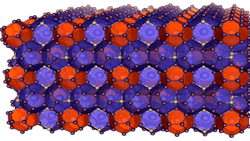Clathrates Outperform Nickel Catalysts for Hydrogen
A research team at Helmholtz Center Berlin for Materials and Energy has discovered that clathrates — materials with complex cage-like structures — perform remarkably well as catalysts for electrolytic hydrogen production, outperforming conventional nickel-based catalysts in both efficiency and durability. This finding represents the first investigation of clathrates for this purpose, according to a news release.
The study, published in "Angewandte Chemie," focused on Ba₈Ni₆Ge₄₀ clathrates, which consist of polyhedral cages made of germanium and nickel that enclose barium atoms. While clathrates were previously known for applications in thermoelectrics, superconductors and batteries, their potential as electrocatalysts had not been explored.
Hydrogen production through water electrolysis requires efficient catalysts, particularly for the oxygen evolution reaction (OER) at the anode, which typically slows down the process. The researchers found that Ba₈Ni₆Ge₄₀ not only exceeds the efficiency of nickel oxide catalysts at industrial-level current densities but also maintains high stability over extended operation periods.
The team uncovered the mechanism behind this exceptional performance through in situ X-ray absorption spectroscopy and structural characterization. When exposed to an electric field in aqueous electrolyte, the clathrate undergoes a dramatic structural transformation: the germanium and barium atoms (comprising 90% of the initial material) dissolve from the three-dimensional framework, leaving behind highly porous, sponge-like nickel nanolayers. This transformation creates maximum surface area for the catalytically active nickel centers to contact the electrolyte.
The researchers suggest that similar results might be achieved with other transition metal clathrates, potentially opening up a new class of materials for electrocatalysts. Such advancements could accelerate the production of "green" hydrogen — a climate-neutral energy carrier produced using renewable electricity — which is vital for future energy systems and the chemical industry.
Lead image: Ba₈Ni₆Ge₄₀ consists of polyhedral cages of nickel (gray) and germanium (purple), each containing a barium atom.
